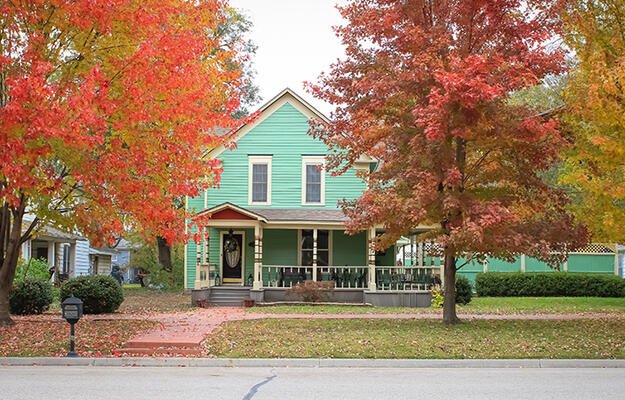
(SeventyFour/Shutterstock)
School Segregation Is Prevalent in the Suburbs, Not Just between Cities and Suburbs
- Title:
-
Racial-ethnic segregation and educational inequality across the urban-suburban divide
- Author:
-
Ann Owens and Peter Rich
- Source:
- Publication Date:
-
2023
Historically, the suburbs have reflected and perpetuated the nation’s unequal housing and education systems. In the last half of the 20th century, the suburbs offered white families an option to avoid city life and access high-quality schools, leading to racial, ethnic, and economic segregation between urban and suburban school districts. But in recent decades, as suburban communities and school districts diversified, between-district segregation has become increasingly common. This study explores how suburban and city school districts contribute to segregation and racial inequality across metropolitan school systems.
This study uses metropolitan areas as broad units of analysis, with the school and neighborhood being the smallest unit of analysis. The authors analyzed data from the National Center for Education Statistics’ Common Core of Data (CCD), which includes 44,446 elementary schools that enrolled at least five fourth-graders in 2015–16 with an additional 10,190 private schools serving at least five fourth-grade students in the CCD Private School Survey file from 2015–16. They matched school districts to metropolitan area divisions, creating a total sample of 6,644 school districts and 48,206 public and private elementary schools, representing 86 percent of all fourth-grade students in 2015–16. They sorted these into urban and suburban geographies, based on district overlap with the largest city in each metro area.
They then analyzed segregation between racial-ethnic dyads, which they termed white-Black, white-Hispanic, and white-Asian groups (because of sample sizes they could not focus on other categories, including multiracial and Native American). They computed total segregation for schools and then used decomposition methods to analyze how much of the total owes to segregation within districts versus between them, looking specifically at segregation between urban and suburban areas and among suburbs. They also measured inequality in school poverty rates, using the percentage of children receiving free or reduced-price lunch (FRPL), and in test score achievement levels and growth using Stanford Education Data Archive data.
Their analysis found considerable public school and residential segregation between urban and suburban districts and among suburban districts, with the highest levels of segregation between Black and white students. Though findings demonstrate the persistence of suburbs as havens of white exclusion, they also found racial diversity among suburbs and evidence that residential sorting between suburban school districts has become an important part of regional school segregation and inequality.
Key findings
School and neighborhood segregation measures
- Total school segregation in 2015–16 shows that white and Black children are very unevenly distributed across schools within metropolitan areas, with the highest level of Black-white segregation in the Milwaukee-Waukesha–West Allis school district.
- Segregation between private and public schools accounts for a small share of total school segregation (2 percent) overall, though this is more pronounced in some large districts, such as Philadelphia.
- The urban-suburban divide explains 38 percent of total public school Black-white segregation and accounts for 60 percent of total between-district Black-white segregation.
- Hispanic-white and Asian-white public school segregation is lower than Black-white segregation, and there is less segregation between urban and suburban districts for Hispanic-white and Asian-white public schools (27 percent and 16 percent, relative to 38 percent for Black-white segregation). This may be because of ongoing Black suburban exclusion and continued patterns of white flight and disinvestment.
- Segregation among suburban schools accounts for 39 percent of total Black-white segregation, which is a greater share than that explained by the urban-suburban divide, suggesting Black students remain concentrated in a smaller number of schools.
- Forty-seven percent of total Hispanic-white school segregation occurs in suburban schools mostly because of sorting between school districts.
- Asian-white segregation is lower overall, and most total segregation (57 percent) is because of segregation among suburban schools, which may reflect earlier suburbanization among Asian Americans and greater income diversity.
- Residential segregation tracks closely with educational segregation for each racial-ethnic dyad, but residential segregation is slightly lower than school segregation (except for Black-white segregation within urban districts).
School inequality measures
- Inequality between urban and suburban schools accounts for 51 percent of total inequality in FRPL composition between white and Black students.
- Black students experience particularly high rates of FRPL in urban schools. Attending suburban schools provides a greater reduction in school FRPL composition for Black students, even though in absolute terms, Black suburban students are still exposed to higher FRPL rates.
- Although Hispanic students also attend schools with high rates of FRPL, the urban-suburban divide accounts for just 39 percent of inequality between Hispanic and white students (compared with 51 percent of the inequality for Black and white students).
- FRPL rates are lower for the average Asian student, with very little Asian-white inequality in exposure.
- School test score achievement levels are unequal by race, with the average Black student attending a school with a mean test score one standard deviation below that of the average white student. The urban-suburban divide accounts for a large proportion of Black-white inequality in school test score levels both because Black students are less likely to attend suburban schools, which have higher test scores, and because suburban schools provide a greater test score advantage for Black than white students.
- Urban-suburban inequality accounts for 59 percent of total Black-white test score growth inequality, a greater share than any other measure. Inequality in test score levels is much larger than test score growth.
A substantial portion of public school and residential segregation (more than one-third for Black-white segregation) is because of segregation between a single urban district and all suburban districts. Suburban school poverty rates are lower, while suburban schools’ test score levels and growth are higher than those of urban schools, and the urban-suburban divide accounts for half of Black-white inequality in these measures. The urban-suburban divide is a weaker stratifying force for Asian-white and Hispanic-white comparisons.
Policy Implications
- Scholars should consider moving beyond the urban-suburban divide to also evaluate differences within urban and suburban districts.
- The authors argue jurisdictional boundaries—both municipal and school—are key drivers of racial- ethnic inequality in opportunities and outcomes, including in education. And these boundaries are also often drawn to preserve advantaged groups’ advantages, such as majority-white school district secession or political district gerrymandering. Policies that overcome these barriers may be necessary to achieving inequality, though past legal decisions and the structure of local governance limit the progress that can be made.
- Voluntary programs and policies provide examples of strategies to reduce the persistence of the urban-suburban divide, such as the METCO program, which voluntarily integrates schools between Boston and its suburbs, and magnet schools, such as those in San Antonio and Hartford, that have successfully drawn in families with higher incomes from the suburbs.


